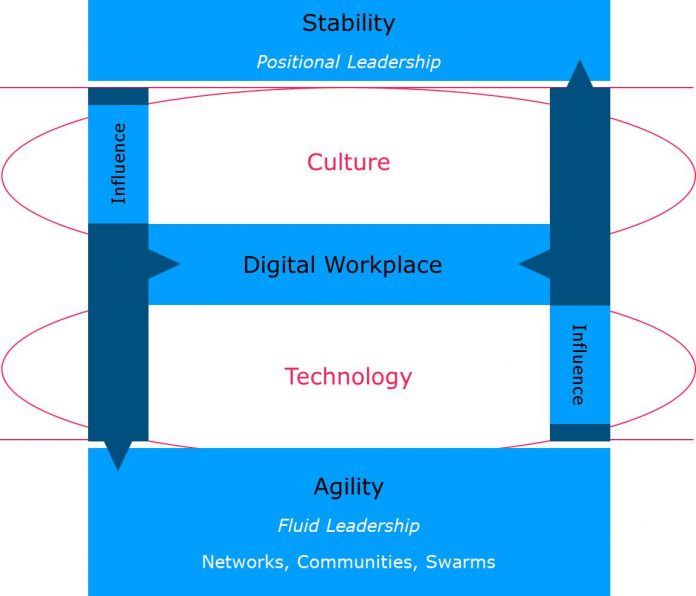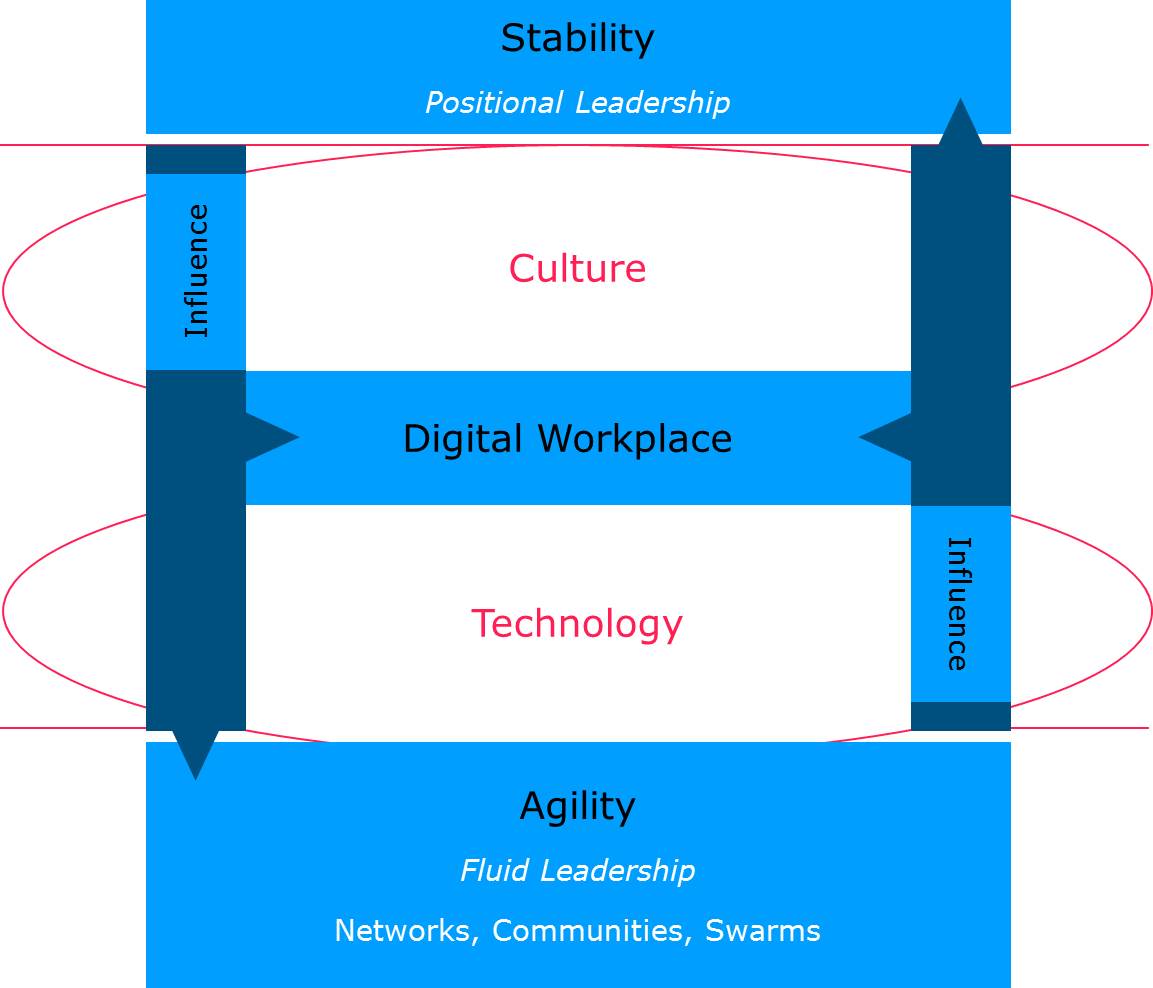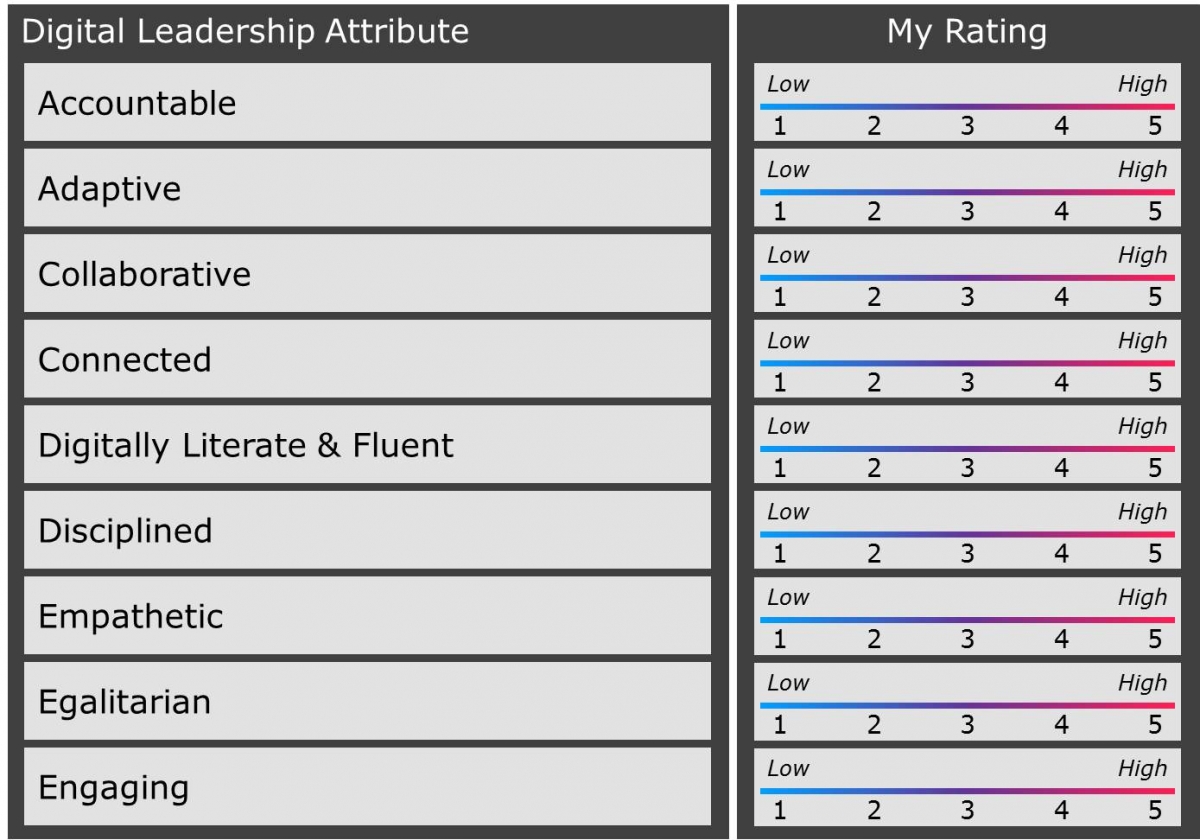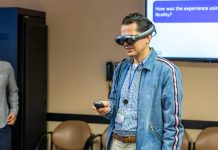
The pace of technological change is so fast that it can be difficult to understand its current implications for leadership. You might have heard of Martec’s Law: Technology changes exponentially, organizations change logarithmically—meaning how an organization thinks and behaves is still hard and slow compared with the rate of technological change.
How can organizations have the stability needed to operate as a recognizable entity, and the agility for swift responsiveness to volatile change? Below is a simple diagram of how I think this will work within a digital workplace.

Leadership influence associated with formal hierarchical positions in the organization provides the stability. Fluid leadership is leadership influence that comes from anyone in any part of the organization. Both types of leadership need to be in a creative tension, but both driven by customer needs and wants.
The downward arrow from the positional leader box represents the value those leaders can bring to fluid leaders, e.g., BHAGs (Big Hairy Audacious Goals), governance policies, overall direction and strategy, decisions that affect the health of the whole organization. The upward arrow represents the value fluid leaders can bring to positional leaders such as specialist expertise, local knowledge, breakthrough ideas, and innovations.
The up-and-down influence channels are patterned because there is a lot of non-linearity of communication in those channels, especially from fluid leadership sources such as ad hoc teams, networks, and communities. Problem-solving and expertise groups can easily form in this fluid leadership space. Sébastien Pacquet, a Canadian academic and blogger, referred to this capability as Ridiculously Easy Group Forming, e.g., groups forming on Twitter based simply on the use of hashtags.
The digital workplace itself is shaped by cultural and technological forces, with culture being the most powerful. You can put a lot of social, mobile, analytical, and Cloud technologies into a digital workplace, but unless the culture drives high levels of openness, transparency, trust, and empowerment, the benefits of digital working will never be realized.
What kinds of leadership attributes are needed in this influence- and technology-based workplace? Below are what I see as the Big Nine:
Accountable: Digital leaders are accountable to themselves, as well as to others. Freeloading (getting by with giving minimal effort) is somewhat easier in a digital space. Often, those collaborating digitally have no direct reporting relationship to others in the group, and don’t feel the need to take the initiative. Those taking on leadership roles in this environment must be extra vigilant in ensuring others are contributing and keeping their promises so recalibration can be done quickly without too much loss. Digital leaders are self-leaders, and expect self-leadership in others.
Adaptive: People in a digital workspace are distributed among different contexts, such as different organizations, geographies, cultures, and professions. One size doesn’t fit all in technology usage, communication style, decision-making, and methods and processes for getting things done. Digital leaders must be open to experimenting and adapting. Awareness of self and others enables mutual understanding and appropriate adaptations to be made.
Collaborative: As Manfred Kets de Vries of INSEAD said recently, “Leadership is a team sport. What’s really at stake here is finding the right combination of complementary talents.” The digital workplace enables emergent and structured collaborations among diverse talents in ways never possible before.
Connected: The digital leader engages actively in networks that cross traditional borders such as silos and hierarchical levels. Weak and strong network ties provide fast and easy access to rich sources of data, information, knowledge, and expertise. This requires digital workplace leaders to pay attention to the breadth and depth of their networks and nurture them by, for example, sharing and reciprocating.
Digitally Literate and Fluent: Influencing others in a digital workplace requires basic skills in using each of the available technologies (digital literacy). It also requires the higher ability to utilize combinations of asynchronous and synchronous tools to achieve best results under different circumstances (digital fluency).
Disciplined: Digital leaders understand that the digital workplace can easily become chaotic and adrift from business goals and objectives. Trusting to chance has a place, particularly when creativity is required, but much of the time, temporary and extended structures, routines, and processes are key to getting best results in a digital workplace. Discipline is also necessary in communication, which needs to be purposeful and clear.
Empathic: Ego management, emotional intelligence, inclusion, and social skills are even more important in a digital workplace, which depends heavily on trust built and maintained without physical presence. When working over distances and through technology, people can easily feel ignored and/or misunderstood. Empathic here doesn’t mean sympathetic; it means the ability to comprehend and respect the worldview of others, without necessarily agreeing.
Egalitarian: The beauty of the digital workplace is that people can contribute their best ideas via social tools no matter where in the organizational hierarchy they sit. Those in the formal hierarchy can contribute direction and guidelines, but ideas and information must flow quickly and easily up, down, and across the organization to add value and be empowering.
Engaging: It’s hard to be influential in a digital workplace without motivating others through your vision, communications, and skills. Digital leaders don’t need to become movie directors, but they do need to take advantage of the media and interactive capabilities of available technologies. Digital technologies enable greater self-expression in the workplace, which can be beneficial in building relationships and trust, but can cause great damage if abused.
How do you rate yourself on the Big Nine?

Terence Brake is the director of Learning & Innovation, TMA World (http://www.tmaworld.com/training-solutions/), which provides blended learning solutions for developing talent with borderless working capabilities. Brake specializes in the globalization process and organizational design, cross-cultural management, global leadership, transnational teamwork, and the borderless workplace. He has designed, developed, and delivered training programmes for numerous Fortune 500 clients in the United States, Europe, and Asia. Brake is the author of six books on international management, including “Where in the World Is My Team?” (Wiley, 2009) and e-book “The Borderless Workplace.”




